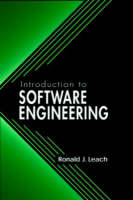
Introduction to Software Engineering
Crc Press Inc (Verlag)
978-0-8493-1445-2 (ISBN)
- Titel erscheint in neuer Auflage
- Artikel merken
Software engineering lies at the heart of the computer revolution. Software is used in automobiles, airplanes, and many home appliances. As the boundaries between the telecommunications, entertainment, and computer industries continue to blur in multimedia and networking, the need for software will only increase, and software will become increasingly complex. Introduction to Software Engineering gives your students the fundamentals of this growing and rapidly changing field.
The book highlights the goals of software engineering, namely to write programs that have all the following attributes: efficient, reliable, usable, modifiable, portable, testable, reusable, maintainable, compatible and correct. The nine chapters cover topics that include project management, defining requirements, software design, coding, testing and integration, delivery and installation, documentation, maintenance, and research issues.
The author uses a hybrid approach, combining object-oriented technology and classical programming techniques to solve computing problems. He also places a strong emphasis on Internet technology and resources. A simple, but non-trivial, running example illustrates all stages of the software engineering process. In addition, where applicable, he covers the impact of Internet technology.
Introduction to Software Engineering presents the basics of software engineering in a concise and direct format. With emphasis on Internet technology, software tools for programming, and hands-on learning, this book effectively prepares students to move from an educational situation towards applying their knowledge to the complex projects faced in the professional arena.
Features
INTRODUCTION
The Need for Software Engineering
Are Software Teams Really Necessary?
Software Engineering
Software Lifecycles
Different Views of Software Engineering Activities
Software Engineering as an Emerging Discipline
Some Techniques of Software Engineering
Standards Commonly Used for Software Development Processes
The Year 2000 Problem and Similar Problems
Organization of the Book
PROJECT MANAGEMENT
Sub-Teams Needed in Software Engineering Projects
The Nature of Project Teams
Project Management
Software Project Estimation
Project Scheduling
Project Measurement
Project Management Tools
The Role of Networks in Project Management
Groupware
An Example: Project Management for a Year 2000 Conversion Project
REQUIREMENTS
Some Problems with Requirements Determination
Requirements Elicitation
Requirements Traceability
Software Architectures and Requirements
Reengineering System Requirements
Assessment of Feasibility of System Requirements
Usability Requirements
Specifying Requirements Using State Diagrams and Decision Tables
Specifying Requirements Using Petri Nets
Ethical Issues
Some Metrics for Requirements
The Requirements Review
The Major Project - Problem Statement
The Major Project - Requirements Elicitation
The Major Software Project - Requirements Analysis
SOFTWARE DESIGN
Introduction
Software Design Patterns
Introduction to Software Design Representations
Procedurally-Oriented Design Representations
Software Architectures
Software Design Principles for Procedurally-Oriented Programs
What is an Object?
Object-Oriented Design Representations
Software Design Principles for Object-Oriented Programs
Class Design Issues
An Example of Class Development - The String Class
User Interfaces
Software Interfaces
Some Metrics for Design
Design Reviews
A Manager's Viewpoint of Design
Architecture of the Major Software Engineering Project
Preliminary Design of the Major Software Project
Subsystem Design of the Major Software Project
Detailed Design for the Major Software Project
CODING
The Choice of Programming Language
Coding Styles
Coding Standards
Coding, Design, Requirements, and Change
Some Coding Metrics
Coding Reviews and Inspections
Configuration Management
A Management Perspective on Coding
Coding of the Major Software Project
TESTING AND INTEGRATION
Types of Software Testing
Black-Box Module Testing
White-Box Module Testing
Reducing the Number of Test Cases by Effective Test Strategies
Testing Objects for Encapsulation and Completeness
Testing Objects with Inheritance
General Testing Issues for Object-Oriented Software
Test Plans
Software Integration
Managing Change in the Integration Process
Performance and Stress Testing
Quality Assurance
Software Reliability
A Manager's Viewpoint on Testing and Integration
Testing the Major Software Project
Integrating the Major Software Project
DELIVERY, INSTALLATION, AND DOCUMENTATION
Delivery
Installation
Internal Documentation
External Documentation
Design Rationales
Installation, User, Training, and Operations Manuals
On-Line Documentation
Reading Levels
A Manager's View of Delivery, Installation, and Documentation
Delivery, Installation, and Documentation of the Major Software Project
MAINTENANCE
Introduction
Corrective Software Maintenance
Adaptive Software Maintenance
Preventative Software Maintenance and the Year 2000 Problem
How to Read Requirements, Designs, and Source Code
A Manager's Perspective on Software Maintenance
Maintenance of the Major Software Project
RESEARCH ISSUES IN SOFTWARE ENGINEERING
Some Important Research Problems in Software Engineering
How to Read the Software Engineering Research Literature
APPENDIX: COMMAND-LINE ARGUMENTS
REFERENCES
| Erscheint lt. Verlag | 24.11.1999 |
|---|---|
| Reihe/Serie | Chapman & Hall/CRC Innovations in Software Engineering and Software Development Series |
| Zusatzinfo | 10 Halftones, black and white; 39 Tables, black and white |
| Verlagsort | Bosa Roca |
| Sprache | englisch |
| Maße | 156 x 234 mm |
| Gewicht | 771 g |
| Einbandart | gebunden |
| Themenwelt | Mathematik / Informatik ► Informatik ► Software Entwicklung |
| ISBN-10 | 0-8493-1445-3 / 0849314453 |
| ISBN-13 | 978-0-8493-1445-2 / 9780849314452 |
| Zustand | Neuware |
| Haben Sie eine Frage zum Produkt? |
aus dem Bereich



